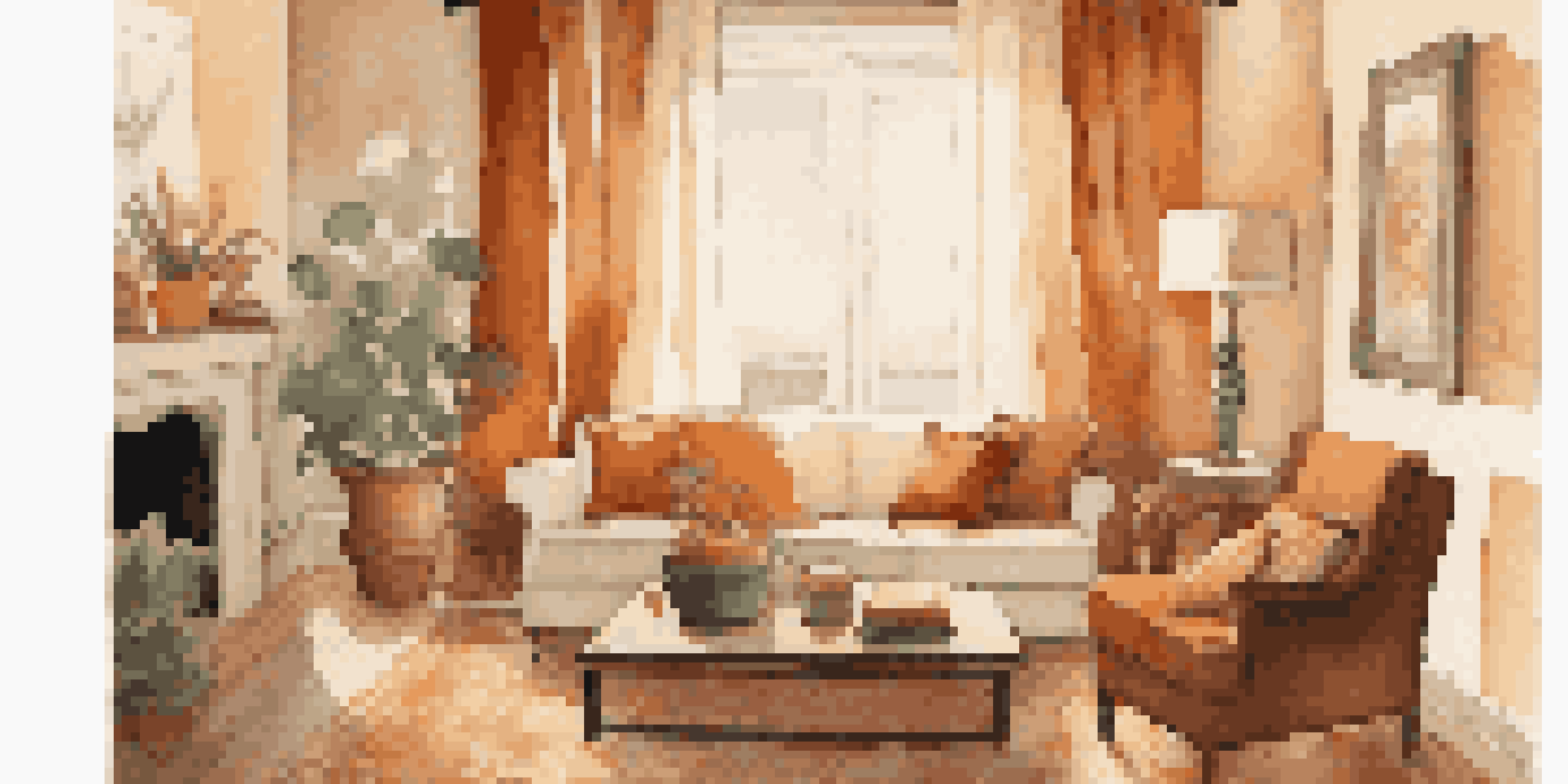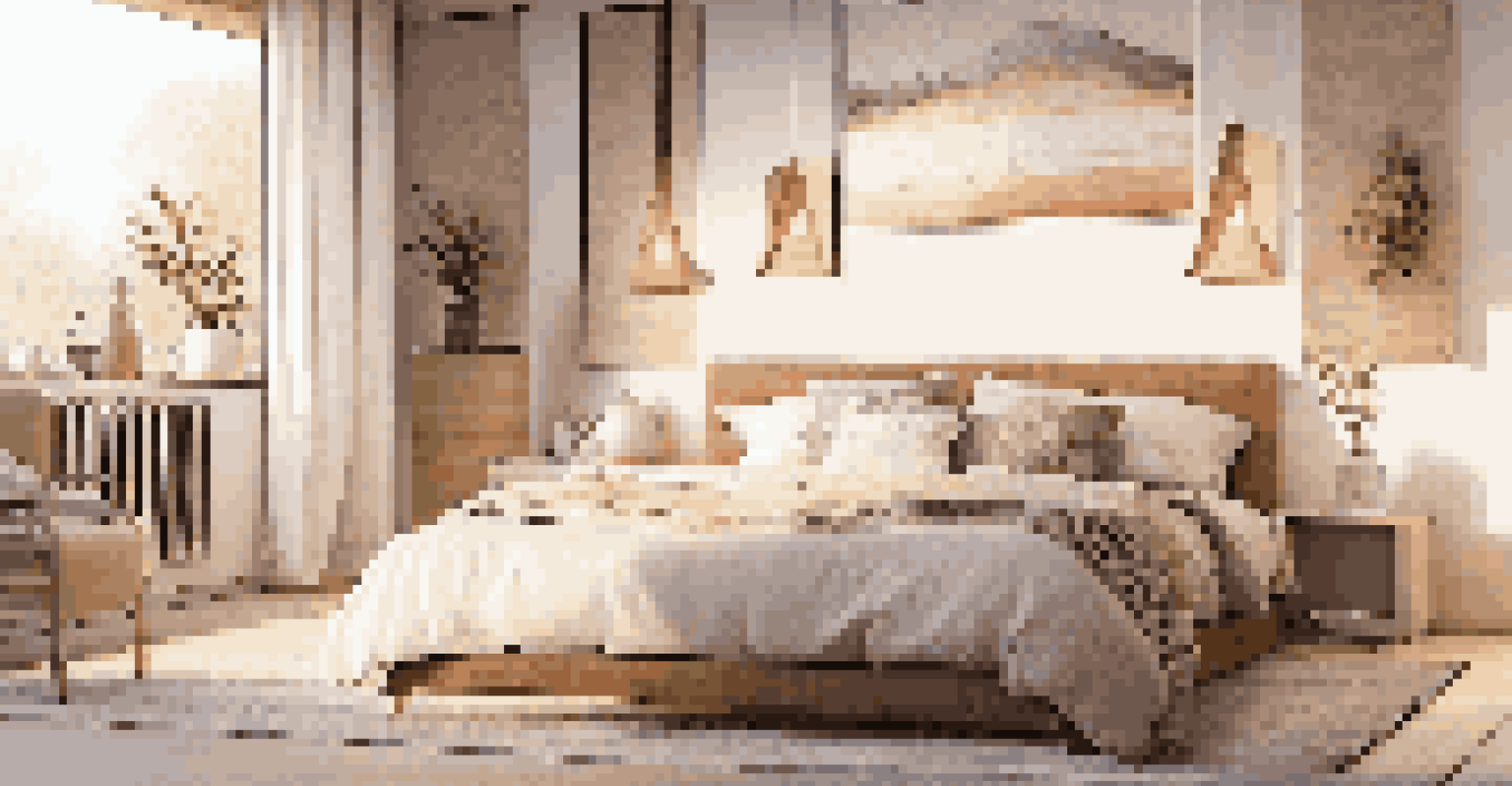Textile Layering: Trends for Cozy and Stylish Interiors

Understanding Textile Layering: The Basics and Benefits
Textile layering is an interior design technique that involves using multiple fabrics to add depth and warmth to a space. By combining different textures, colors, and patterns, you can create a visually appealing and cozy environment. This method not only enhances aesthetics but also serves practical purposes, such as improving insulation and sound absorption.
Textiles can transform a space, adding depth, warmth, and personality to any room.
Think of textile layering like building a delicious parfait. Just as you would layer yogurt, fruit, and granola for a delightful treat, layering textiles involves blending various materials for a harmonious look. The result is a space that feels inviting and designed with care, making it perfect for your home.
Moreover, textile layering allows for personal expression. You can mix and match fabrics that reflect your style, whether it's bohemian, modern, or classic. This flexibility means your interiors can evolve with trends over time, keeping your space fresh and engaging.
Current Color Trends in Textile Layering for Interiors
When it comes to textile layering, colors play a pivotal role in setting the mood of a room. Currently, warm earth tones like terracotta and olive green are gaining popularity, as they evoke a sense of comfort and connection to nature. Pairing these colors with neutrals or soft pastels can create a balanced and inviting atmosphere.

Imagine walking into a room adorned with rich amber cushions set against a soft beige sofa. This combination not only feels cozy but also reflects the natural world outside, bridging the gap between indoor and outdoor living. Such color choices can significantly impact the overall vibe of your space, making it feel more welcoming.
Textile Layering Enhances Aesthetics
Using multiple fabrics adds depth, warmth, and a cozy atmosphere to your interiors.
Don't shy away from experimenting with bold colors either! Jewel tones like emerald or sapphire can add a touch of luxury and drama to layered textiles. The key is to find a balance that resonates with your personal style while fostering a sense of warmth and comfort.
Choosing the Right Fabrics for Layering Textiles
The choice of fabrics is crucial in textile layering, as different materials bring unique textures and moods. Natural fibers like cotton, linen, and wool are excellent for creating a cozy feel, while synthetic fabrics can provide durability and ease of maintenance. Mixing these materials can add richness and depth to your layered look.
Sustainability is not a trend; it's a responsibility that we should embrace in every aspect of our lives, including our homes.
For example, consider layering a soft wool throw over a linen sofa. This combination not only feels inviting but also adds a visual contrast that enhances the overall aesthetic. Just like in a well-prepared meal, the right ingredients— or fabrics in this case—can elevate the experience.
Also, don’t forget about the power of patterns! Incorporating patterned textiles, such as geometric prints or floral designs, can add a lively touch to your space. The key is to balance patterns with solid colors to avoid overwhelming the room, ensuring each layer complements the others.
Layering Techniques: From Throws to Wall Hangings
Layering isn't just about cushions and blankets; it encompasses various elements throughout your space. Throws, for instance, can be draped over furniture or used as a cozy accent on beds. This simple technique instantly adds warmth and texture, making your space feel lived-in and inviting.
Wall hangings are another fantastic way to incorporate textile layering. Tapestries or fabric art can create a stunning focal point while adding depth to your walls. Imagine a soft, textured wall hanging above a minimalist bed— it instantly transforms the area into a cozy retreat.
Color and Texture Create Mood
The right combination of colors and textures can evoke feelings of comfort and style in a space.
Lastly, don't overlook the flooring! Rugs can be layered to define spaces and add warmth underfoot. A larger neutral rug topped with a smaller patterned one creates visual interest and can help separate areas in open-plan spaces, blending style with functionality.
Seasonal Textile Layering: Adapting to Weather Changes
One of the joys of textile layering is its adaptability to seasonal changes. As the weather shifts, so can your textile choices, allowing you to create a warm, inviting space in winter and a cool, refreshing feel in summer. For instance, heavier fabrics like wool and velvet are perfect for colder months, while lighter linens and cottons keep things breezy in the heat.
Think of it as dressing your home for the seasons. Just as you swap out your winter coat for a summer dress, you can change your textile layers to suit the climate. This not only keeps your space comfortable but also injects a sense of freshness and excitement throughout the year.
Incorporating seasonal elements, such as autumnal hues or spring florals, can keep your décor feeling current. This approach allows you to express your creativity while ensuring your home remains a cozy sanctuary, no matter the time of year.
Combining Different Textiles: Tips for a Cohesive Look
Combining different textiles can be a bit daunting, but with a few tips, you can achieve a beautifully cohesive look. Start by selecting a color palette that ties your textiles together, ensuring that they complement rather than clash. This foundational step will guide your choices and create a harmonious vibe throughout your space.
Next, focus on varying textures. Combining smooth fabrics with tactile ones, like mixing a soft velvet with a rough linen, adds depth and interest to your layers. This approach invites touch and creates a more engaging environment for anyone who enters your home.
Sustainable Choices Matter
Opting for eco-friendly fabrics not only benefits the environment but also enhances the beauty of your home.
Lastly, allow for some breathing room between your layers. Too many patterns or textures in a small area can become overwhelming. Intentionally leaving spaces or using solid colors will give your textiles room to shine, making the overall design feel more curated and purposeful.
Sustainable Textile Choices for Layering Trends
As we embrace textile layering, it's essential to consider sustainability in our choices. Opting for eco-friendly fabrics, such as organic cotton, hemp, or recycled materials, not only supports the environment but also creates a healthier living space. Many brands now offer stylish, sustainable options that don’t compromise on aesthetics.
Imagine draping your sofa with a beautifully patterned throw made from recycled fibers. Not only does it look great, but it also tells a story of environmental consciousness. By choosing sustainable textiles, you contribute to a more sustainable future while enhancing the beauty of your home.

Additionally, investing in quality pieces that are durable and timeless means you’ll need to replace them less frequently. This longevity is key to reducing waste while ensuring your layered textiles remain stylish and functional for years to come.